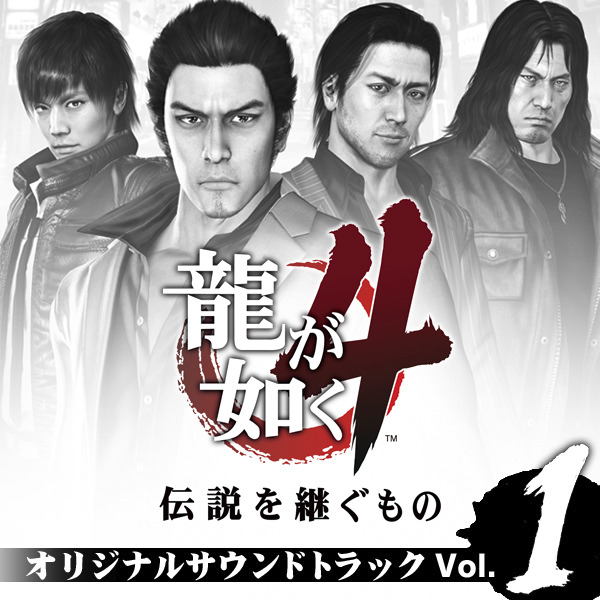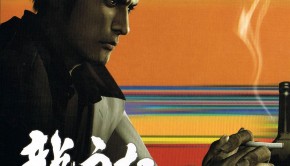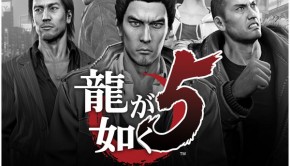Yakuza 4 Original Soundtrack Vol. 1
 |
Album Title: Yakuza 4 Original Soundtrack Vol. 1 (Ryu ga Gotoku 4 Densetsu wo Tsugumono Original Soundtrack Vol. 1) |
| Record Label: SEGA |
|
| Catalog No.: N/A |
|
| Release Date: March 24, 2010 |
|
| Purchase: Buy at iTunes |
Overview
Yakuza 4 Original Soundtrack Vol. 1 (or Ryu ga Gotoku 4 Densetsu wo Tsugumono Original Soundtrack Vol. 1 in Japan) is the first of two soundtracks released digitally for the game. As per the usual, it features compositions by a large number of Sega artists, and for the most part keeps with the style of the Yakuza series in terms of music. This volume mostly includes action tracks for battles and and action sequences, though it also has the new main theme of the game and a few other story-relevant tracks. The division of the soundtrack into two volumes should not suggest that the material in each is equivalent to a disc, as this first volume carries nearly two hours worth of material.
Body
The album begins with the new main theme, “For Faith”. It’s a J-rock track composed by Hidenori Shoji with a bit of piano and synth featuring male vocals. It’s composed well enough with a good progression from the verse to chorus, and it also has a solid instrumental bridge, though the rather nasal vocals and poorly pronounced English might be a bit off-putting for some. For those looking for alternatives, four other instrumental versions of the theme are present at the end of this volume. “Four Face” is built largely from the same elements of the original minus the vocals, but the while the arrangement is similar, it is not identical. Notably, the verses follow a different melody, giving the track a more serious feel. “Four Faith” has less melodic focus and a grittier rock sound overall, though it does have quiet sections making the track more dynamic. “For Face” is lighter with piano focus, although the band is still there for support. The strings bring in the melody later, but unfortunately they are of lower quality, hampering an otherwise solid and different rendition. Lastly there is “For Faith (Instruments)”, which brings back the fuller band sound. It more closely follows the original version, but still carries some markedly different lines, and the electric guitar sounds great when it comes in with the chorus melody.
The two new versions of the series’ “Receive You” theme are also notable. “Receive You and Bite You” is one of the most intense versions of the theme yet, with hard hits and fast-paced synth rock sound. It is a bit repetitive, and the melody doesn’t stand out much either, but it is an entertaining track. “Receive You The Ballad” is a power-ballad version of the track with only female vocals throughout. Again the English pronunciation is quite bad, and the vocal itself isn’t anything special, but the track builds well throughout, from a quiet beginning to a powerful end.
The central aspects of this volume are the rock battle themes, as well as other upbeat and intense tracks. A new version of “Skirmish” is present and has been noticeably beefed up with an edgier sound. There’s some solid soloing from the guitar, though I did feel the track should not have been looped. Thankfully this isn’t a problem for too many tracks. Another great track is “Massive Fire” which alternates between calmer segments with a touch of funk to more intense and quick sections with lots of adrenaline. “Broken Police Radio” has a great riff and a more laid back feel that makes the track more fun. “The Myth” has a strong pace and a growling sound all throughout that is great, and the track only gets better as it goes along. “Solitude” is a pretty varied number with some melodic segments interspersed and an emotional touch. Some of the tracks are not as remarkable like “Theme of Saigoh” or the slightly psychedelic “Theme of Naile” which, while still providing a general atmosphere of intensity, tend to be a bit repetitive or meandering. They work quite well in the game, they’re just not as strong as the other tracks. They also don’t do much more than similar tracks from the previous entries of the series, but they carry on the legacy well.
Some tracks pull in other influences, often to good effect. Some use electronic elements like the “Underground Dazzling Star” tracks, with the lighter “Neo” and the heavier “Mashup” version. There is also “All my pride” with a vocal samples throughout and high energy. Some great rock tracks with strings include “to the abyss” with a twisted spy theme to its sound, or the more epic and dark orchestral “Teufel mit Liebe”. “Theme of Sennin” is solid with a mix of oriental and jazz elements in addition to the rock, and “Infinite Handcuff” has a great bassline leading the way for fun improv from both the electric guitar and the piano. These tracks keep the energy of the soundtrack high while also varying the sound just enough.
Some of my favourite tracks of the album were those which incorporated jazzy influences and a predominant saxophone. A few of these kinds of tracks are present on earlier soundtracks, but they are at their best here. They start with the wonderful “Whiskey & Rhapsody”, a midtempo track with a mix of jazzy chords, improvising saxophone, and reversed musical samples that make for a trippy atmosphere. “Nervousness” is more upbeat, adding guitar to the mix. There’s a great groove with the bass, and it all feels more smoke-y with a heavier atmosphere and noir influences mixed with a modern sound. It’s a lot of fun, and is one of my favourites of the album. “Fang Marked Viper” is more tense but still retains its an active bass and percussion to drive the track, and the saxophone is great with its arpeggiations. “Spicy Brass Squad” is a more traditional sounding arrangement, but that renders it a bit less interesting than the others around it, fun as it still is with soloing. “Rebellions” is a wonderful track carrying a busier sound and a slightly manic atmosphere. The slight oriental feel somehow goes great with the jazz and noir mix. “Speed Star” takes a rock heavy influence, giving the track more bite than the previous ones. All in all, this is an excellent segment of the soundtrack, expanding on the Yakuza series sound with flair and style.
The soundtrack only has a few quieter moments. “Roarless Dragon”, the new version of the series’ title BGM is an ambient track in line with its predecessors, but with more going on. It has a nice echoing atmosphere and an ethereal sound with its synths, though like its predecessors it also doesn’t do much. Better are the piano-centric tracks, “Sadness” and “Glee”. The former is lightly jazzy with some simple figures and decoration, played moodily and evocatively. The latter is more straightforward with some string support, though here the synth instruments don’t sound quite as good, and it is also overly sentimental, a feeling heightened by the contrast with the rest of the intense soundtrack. The more atmospheric tracks include the smoky “Mood of disquiet”, the tense “Criminal Delights”, and the moderate “Geist Obscuration”, though they merely perform their function. “The Finale” is the token closing orchestra piece of the soundtrack. It’s cinematic with a mostly uplifting sound, especially when it builds to its end, but its otherwise very generic, having a weaker sound and nothing particularly memorable about it. This partly stems from the lack of recurring thematic material and prominent themes in the score.
Summary
Yakuza 4 Original Soundtrack Vol. 1 is another great soundtrack in the series, carrying on its frenetic action themes while also expanding it with a strong dose of jazz and a few other musical influences. It may be a bit repetitive for fans who have followed the series up until this point, and the soundtrack is perhaps a bit overstuffed with these high-octane tracks, but given its low price and large quantity the album is certainly worth it. The few quieter tracks are mostly decent as well, and the new main theme is solid. This volume doesn’t include many of the other musical colours of Yakuza 4, such as the club and karaoke tracks, but for anyone who charged through the game just for the main story and battles, this volume has it all.
Do you agree with the review and score? Let us know in the comments below!
4
Posted on May 25, 2016 by Christopher Huynh. Last modified on May 25, 2016.














